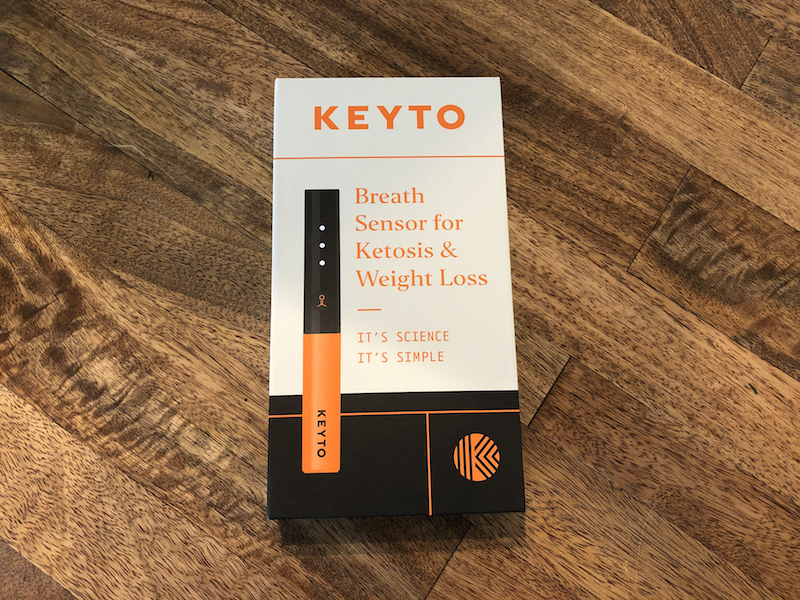
I’ve been practicing intermittent fasting for a couple of years now.
IF comes with a lot of hype, as people claim that your body “burns through fat” the entire time and it’s the fastest and easiest way to lose weight.
I mostly use IF for appetite control, better energy, and the other health benefits — but the idea of being in a fat-burning state of ketosis is certainly appealing.
Until now, I haven’t really had any way to know if that was true or just a bunch of hooey.
Then I heard about Keyto.
Keyto is a breath sensor, designed for people following the ketogenic diet, that can instantly tell you if your body is burning fat or carbs for energy.
I recently got my hands on one and decided to put it to the test, so here’s my hands-on Keyto breath sensor review!
Overall, the Keyto device is really easy and fun to use — plus the Key Eats app is packed with useful features for anyone on the ketogenic diet.
I can’t say for sure how accurate it is since there’s not a good, convenient way to double-check the results (and I’m not interested in peeing on a stick or pricking my finger), but my results were really illuminating and educational.
I’d say this is almost a must-own tool if you’re struggling to stay on track with Keto and need better accountability, progress tracking, and meal ideas.
Now let’s take a closer look.
(Or grab your Keyto sensor right here.)
What is Keyto & how does it work?(Plus Keyto unboxing)
Keyto is a state-of-the-art breath sensor that detects acetone levels in your breath, thus determining if your body is in a state of fat-burning ketosis, or if your body is using carbohydrates for energy.
The device and accessories come in a gorgeous box. This thing is REALLY nicely packaged, with a slick magnetic flap that allows it to open like a book and show the device and all attachments beautifully displayed.
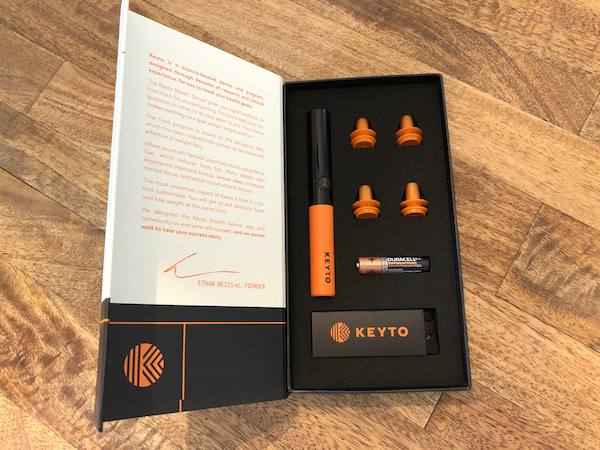
You can see above that it comes with:
- the sensor itself
- four mouthpiece attachments (so you always have a clean one or can share with others)
- a single AAA battery
- and a slick carrying case
- along with a basic quick start instructions guide.
Let’s look at the sensor itself.
It’s a long, cylindrical device that kind of resembles a vape pen.
Keyto is about 6 inches long and has a diameter of around .75 inches. It’s lightweight but sturdy, weighing a little bit more than a thick Sharpie marker.
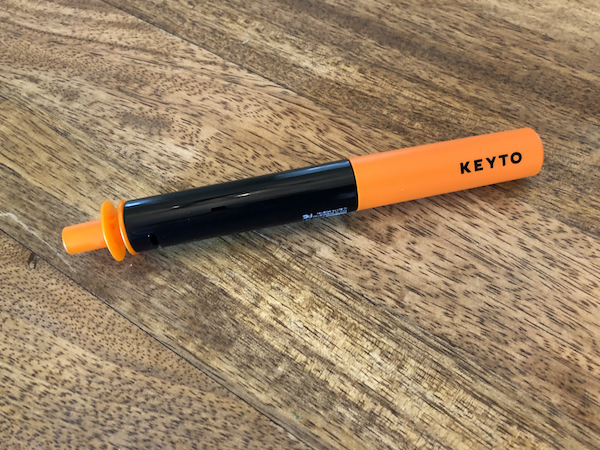
How does the Keyto breath sensor work & what does it do?
Once you open the box, set up is pretty quick and easy.
You’ll pop the included battery into the device, and then you’ll need to download the Key Eats app from the app store.
(As far as I know, you can’t use the device without the app.)
It’ll take just a few minutes to:
- Create a free Key Eats account
- Enter some vital information like your gender, age, weight & goals
- Pair your Keyto device to the app using Bluetooth
Then you’re ready for your first reading.
Power the device on by hitting the small, circular button on the side, then hit the + sign inside your app.
The device needs to warm up (explained below) before it can get an accurate reading.
You’ll get a helpful progress bar that lets you know when Keyto is ready to use — it should take about a minute or so to reach the proper internal temperature.
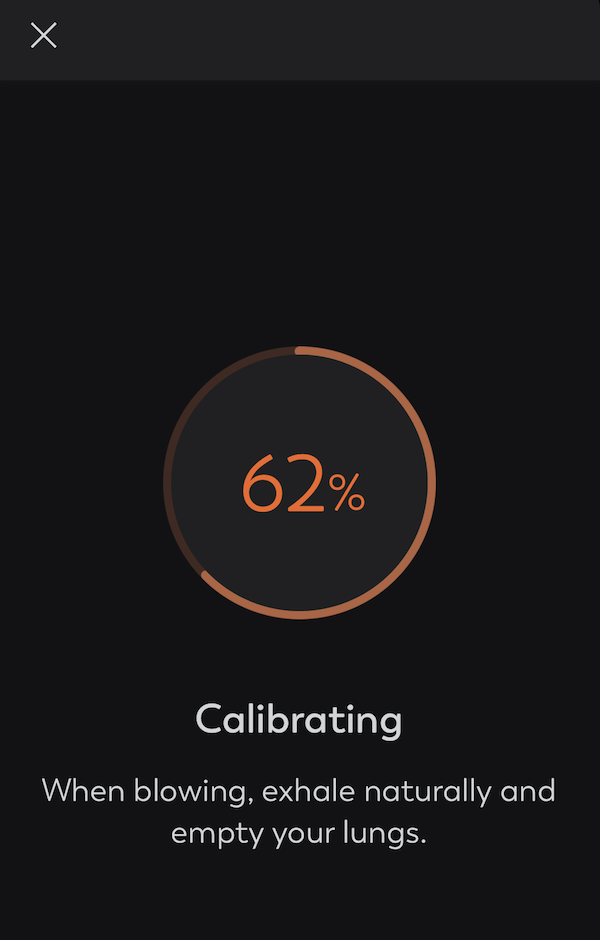
Then, you place the sensor’s mouthpiece between your lips and blow out (naturally, not forcefully) until the very end of your breath.
The device will register the presence of acetone in your breath and assign you a Keyto Level that corresponds to your current level of ketosis.
(You’re not simply in our out of ketosis. There are multiple levels, from light to heavy, which corresponds to a Keyto Level of 1 through 8.)
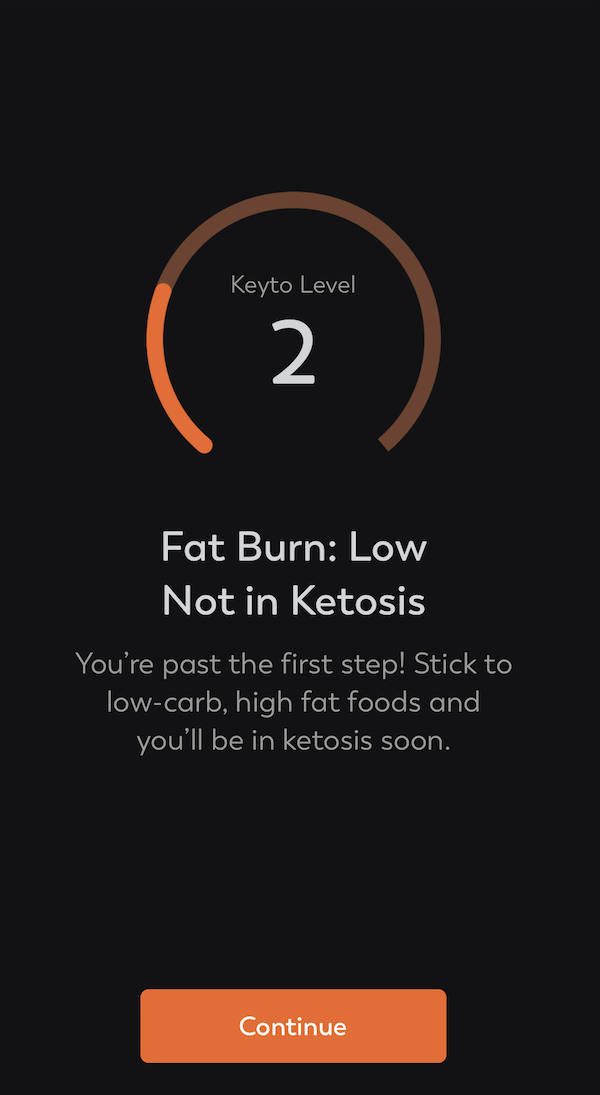
Each time you get a reading, the Key Eats app will give you feedback like if you need to stay the course, or if you may need to make some dietary adjustments.
Each reading is saved and logged, along with any notes you put in about what you’ve eaten and how you’re feeling, so you can track your progress over time.
How does Keyto detect acetone?
The Keyto operates by detecting something called acetone, which is a key component of ketone bodies formed during prolonged fasting or following the ketogenic diet.
They can be found at the bottom of your lungs and can be present in your breath (and urine!), which is why some people say the ketogenic diet gives you breath a distinct smell — the odor can be a bit fruit or even resemble nail polish.
The science is beyond my pay-grade, but inside the slick housing is a “nanostructured gas sensor”.
The sensor, once heated to a whopping 400 degrees celsius (don’t worry — the outside doesn’t even get remotely warm), is specifically engineered using a combination of elements that make it perfect for detecting acetone in your breath.
As you breath passes through the device, changes in conductivity due to acetone levels are read by electronic components and translated into a ketosis score, or your Keyto Level.
The development of the sensor was led by an expert team headed up by two world-class cardiology and metabolism doctors.
If you’re interested, read more about the science behind the Keyto sensor here.
Or get Keyto right here to see for yourself.
Does the Keyto sensor work for ketosis and the Keto diet? (My results)
I mentioned it above but it bears repeating.
I don’t actually follow the ketogenic diet, but I do follow a loose intermittent fasting schedule.
(The closest would be 16:8 — though I usually just fast for about 6 hours after I wake up.)
I’ll often have black coffee in the morning, water, sugar and sweetener-free sparkling water, and sometimes a pre-workout before I eat lunch.
So how did Keyto work for me?
My first readings of the day (roughly 10 hours after my last meal or snack) were, not surprisingly, low — either a 1 or 2.
Although my food may be fully digested, when I wake up my body is still typically running on carbs — which isn’t totally surprising.
Quick note: The readings seem to be more ballpark rather than pinpoint accurate.
There were times when I would get a reading of 2 (meaning your body is approaching ketosis), and then an hour later without eating or drinking anything but water, my reading would go back down to 1 (not in ketosis, body using carbs for energy).
Either way, the reading is low and the actionable feedback is to continue fasting or eat high fat, low carb foods.
What surprised me was that my readings stay low deeper into my fasts and even after my fasted workouts.
I typically exercise about 4-5 hours after I wake up on an empty stomach other than a pre-workout.
By the time I’m done and home, I’m 16+ hours into fasting.
(Read: How I fight hunger when fasting.)
I was curious if this would be enough to trigger ketosis and it seems, based on my Keyto readings, that it’s not.
My readings (they could be influenced by my pre-workout, to be fair — there’s some evidence that artificial sweeteners can trigger an insulin response) were still in the 1-2 range even after 16 hours of fasting and a big workout.
My biggest takeaway? Ketosis is not a state your body easily slips in and out of.
I’ll experiment with Keyto and longer fasts (read: the time I fasted for 24 hours) but it seems shorter fasts, though they have many benefits, don’t trigger your body to enter a fat-burning state.
To get the biggest fat-burning benefits out of ketosis, you need to have your diet really dialed in if you’re following keto. (In other words, “kind of” being on keto isn’t going to cut it!)
The Keyto sensor and app really help you see when and where you’re falling off the wagon, and give you actionable feedback you can use to get back on track.
Read more reviews of Keyto from real people here & grab yours.
The Key Eats App (What’s inside)
Along with the sensor, you’ll definitely want to explore the Key Eats app.
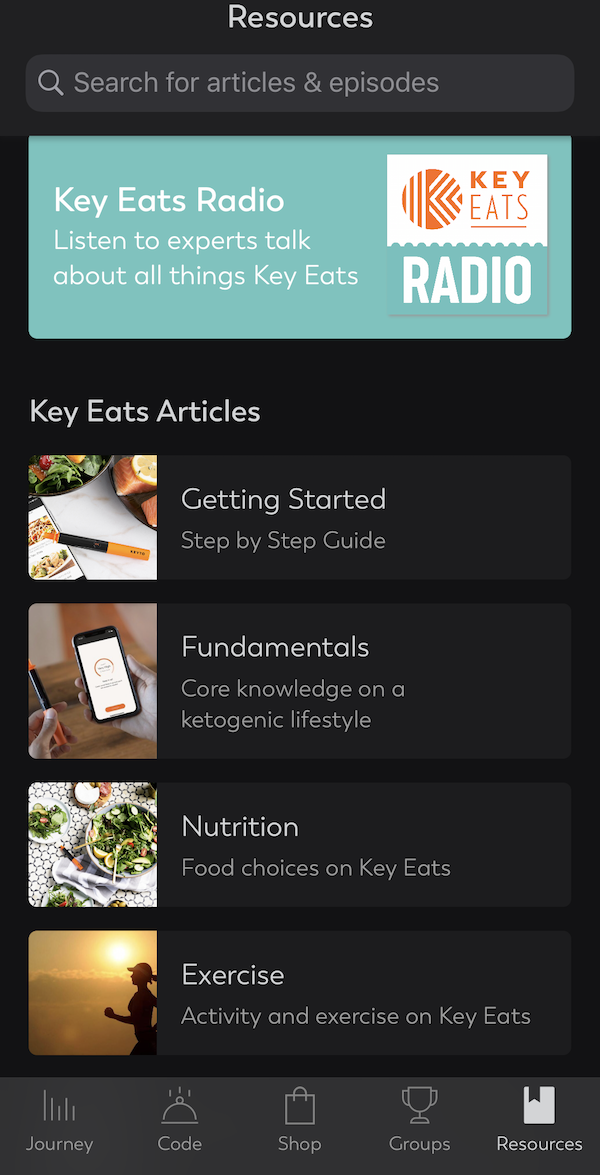
(Buying the breath sensor gets you 14 days free as a premium user, though there is some nice free content on the app, as well.)
The app tracks all of your Keyto readings along with notes. Dates and times are automatically logged, but you might want to make a note of what you ate, how you were feeling, etc.
The Key Eats app also gets you access to tons of:
- keto recipes
- meal plans
- shopping lists
- articles
- and pocast episodes
There’s also a store where you can order keto meal bars and other goodies.
It’s a great all-in-one keto resource.
If you ever have a question about a food or a workout, want to check in on your progress, or want to create a ketogenic meal plan — everything you need is right here!
I found navigating the app to be pretty simple, but finding the free content isn’t easy.
Most of the good stuff is locked up behind the paywall, and you’ll need to be a Premium member to see it.
How much does Keyto cost?
As of this writing, you can get the Keyto sensor itself for $99.
Buying the sensor gives you a 14-day free trial of premium access inside the app
Premium access gets you WAY more stuff, including:
- Keto-friendly orders for most popular restaurants
- In-depth food guides & nutritional advice
- More articles (what to do about constipation, how to use keto and intermittent fasting, etc.)
- Community access (ask questions, network, etc.)
My favorite feature is the restaurants guide. Need an idea for a keto-friendly order at Panera or Taco Bell? The app has you covered!
Premium normally costs $95.99 per year or $14.99 per month.
Alternatives to the Keyto breath sensor (Pee strips vs breath sensor)
Are there any other ways to tell if your body is in ketosis?
Sure, but you might not like them.
For years now, people have been using Keto Strips, or pee strips, to measure acetone in their urine.
While there are a few advantages to using a pee strip instead of a breath sensor, the Keyto sensor is ultimately a much better experience.
Here’s a quick lowdown on the keto strips:
Pros
- Inexpensive in the short term. You can get about 150 strips for under $10.
Cons
- Strips are disposable and if you test every day, you’ll fly through them.
- Need to have a full bladder to test
- Have to manually interpret results
- Inconvenient
There are also a handful of ketosis breath analyzers available on the market, but they tend to be bulky and frankly don’t have great reviews.
Finally, you can get extremely accurate ketosis readings from doing an at-home finger prick blood test — however, that’s not practical for most people for obvious reasons.
Wrapping Up
Experimenting with the Keyto sensor taught me a LOT about low-carb diets and intermittent fasting, even though I don’t follow the ketogenic diet myself.
After using the sensor and doing further research, I learned it takes your body a few days to use up its glycogen stores (energy derived from carbs) before it can enter its fat-burning state.
So you’ll need to be disciplined in following the keto diet for a while to see the best results, or if you’re using interittent fasting, it’ll take some seriously prolonged fasts.
Either way, the Keyto sensor and Key Eats app are great tools to have in your biohacking arsenal. You can get instant, real-time feedback on what’s happening in your body and translate that into specific action items to help you get better results.
The sensor is pricey upfront, but exceptionally fun and easy to use — not to mention, way more convenient than pee strips and blood tests.
You can get your Keyto right here and read more in-depth reviews from real customers who use it daily on the ketogenic diet.
Hope this helps!